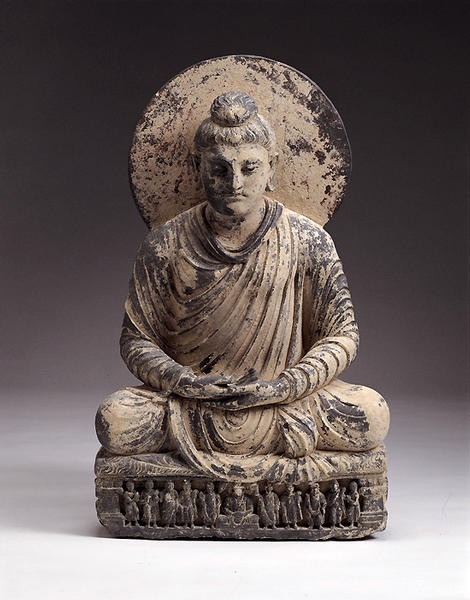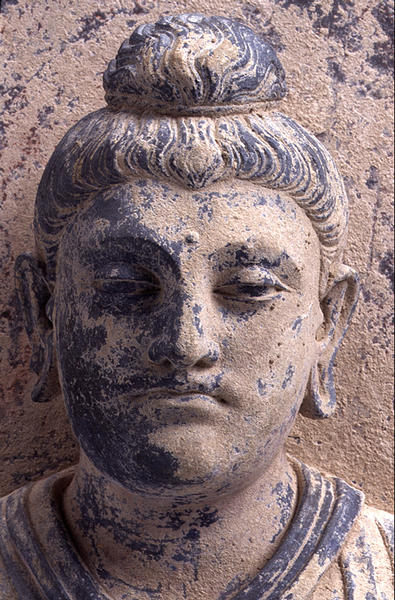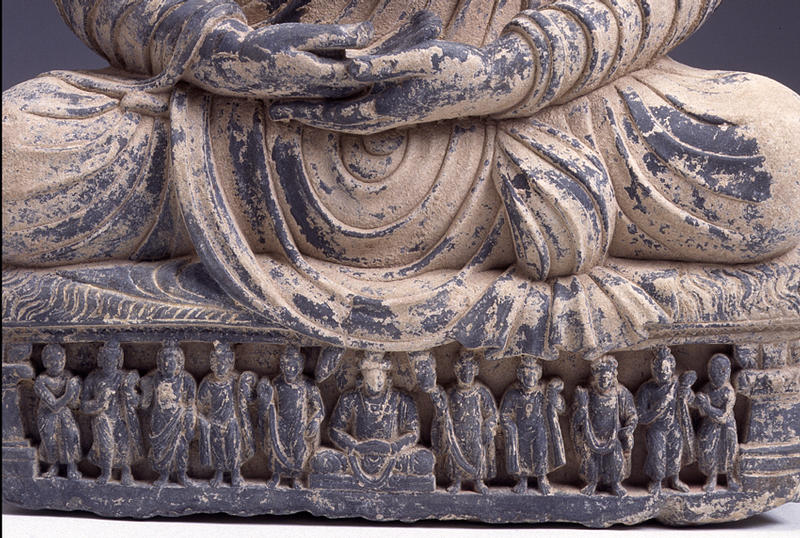Seated Buddha with Dhyana Mudra
- Pakistan, Gandhara
- 2nd - 3rd centuries A.D.
- Schist
- H-68 D-23 W-53.4
Catalogue Entry
The Buddha is shown seated cross-legged on a rectangular pedestal with his hands in the position of meditation, or dhyana mudra. This image is particularly well preserved, with the exception of losses on the lower edge of the Buddha's right ear lobe and the tip of the index finger on his right hand. An undecorated, round nimbus appears behind his head, his long wavy hair is bound into an ushnisha form, between his eyebrows is a small projection for the urna, and he has a mustache. The face is characterized by a calm expression, his eyes are half closed, and he looks deeply inward. The body is covered with a robe that drapes across both shoulders and covers both feet. (This type precedes a late-Kushan-period type of seated Buddha image in which the robe is draped across the left shoulder but the right shoulder is left bare, and the majority of which have their hands in a dharmachakra mudra and their feet exposed.*1) The handling of the drapery in this image is somewhat more formalized than on the standing Buddha (cat. no. 72), and this work is thought to be a bit later in date, yet it has a sense of stability and has not lost any of the power of the form. Traces of lime on the image appear to have been a ground for pigment, but unfortunately the statue's original finished beauty is no longer apparent.
Eleven figures are carved on the front of the pedestal and are framed at either end by pilasters topped with acanthus capitals. At the center of the group is a bodhisattva seated beneath a tree with hands in the position of meditation (dhyana mudra). To his proper right are (from proper right to left) a standing Buddha with the right hand raised in the peace-giving gesture (abhaya mudra) and the left hand lowered; a standing Buddha with right hand pendant, and left hand raised to shoulder height and grasping the edge of the robe; a standing bodhisattva with right hand raised to shoulder height and palm facing forward, left hand lowered and holding a water vase; a standing Buddha with his right hand in front of chest, left hand raised nearly to shoulder height and grasping the edge of the robe; and a standing attendant figure with hands clasped in prayer. The same figures are repeated on the other side of the seated central bodhisattvas to form a symmetrical pairing with the first-named group. The attendants with hands clasped in prayer on either end might be a couple who donated this image. The bodhisattvas holding water vases are generally considered to be Maitreya when they appear in Gandharan images,*2 and even though the central seated figure does not hold a water vase, there is a strong possibility that he too is a Maitreya. The nine figures arrayed across the pedestal, excluding the flanking attendant figures, could be seen as three triads, with Buddha figures to the left and right of a central Maitreya bodhisattva. The theological background for such a grouping of figures remains a fascinating question; however, as there are no other known examples of a grouping of three triads like this, the meaning of this array of figures remains unclear. TK
1 Ingholt, 1957., figs. 245-261.
2 Takata 1979, pp. 11-30, espacially p. 14.


